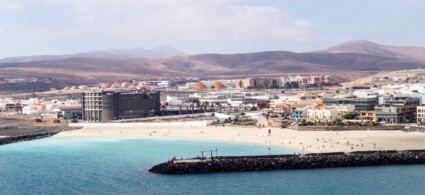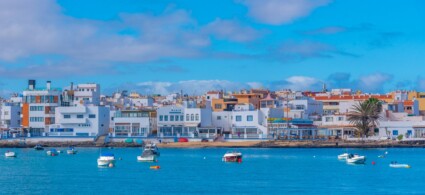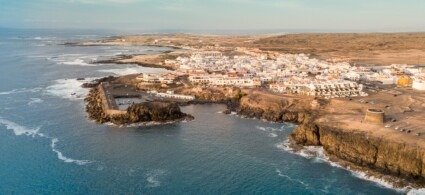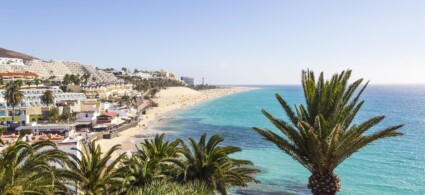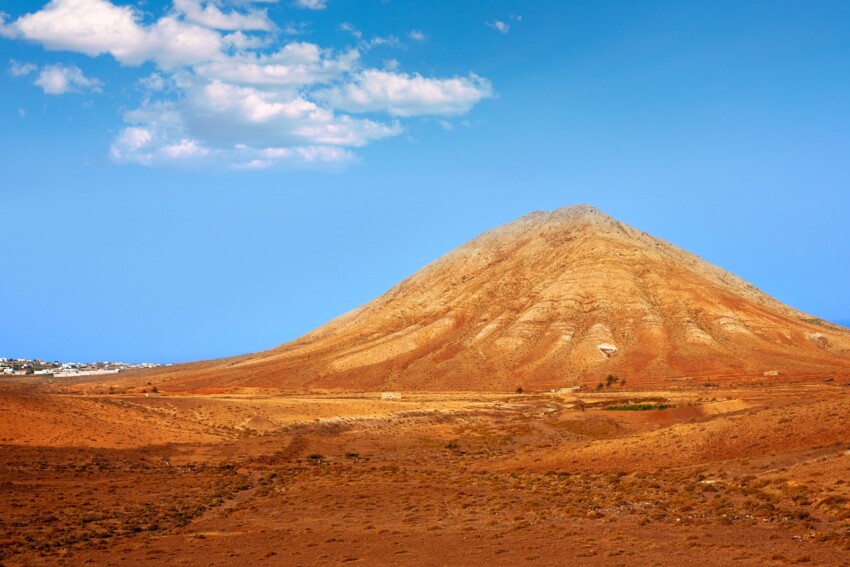

At first glance, Fuerteventura appears to be a bare, desert island with nothing to see, except – of course – for its magnificent beaches. But discerning travellers will notice a number of attractions and sights that are definitely worth seeing. The island is, to begin with, an ideal place for nature lovers: one can get so deeply in touch with nature that one forgets to be close to civilisation.
A slow and seductive pace of life then awaits visitors to the inland villages of Fuerteventura. Think white stone houses, small stone dwellings with lava beams, palm-shaded alleys and mountain views. Those who decide to dedicate a day to exploring these villages should definitely choose two: Betancuria and Antigua.
In addition, there are high-level attractions in Fuerteventura, including theme parks and the possibility of taking part in dolphin-watching tours. Finally, museums and monuments. Of course we are not talking about the Prado, but the museums of Fuerteventura are worth a visit, especially for those who decide to delve into the history of the island and the civilisations that have settled it.
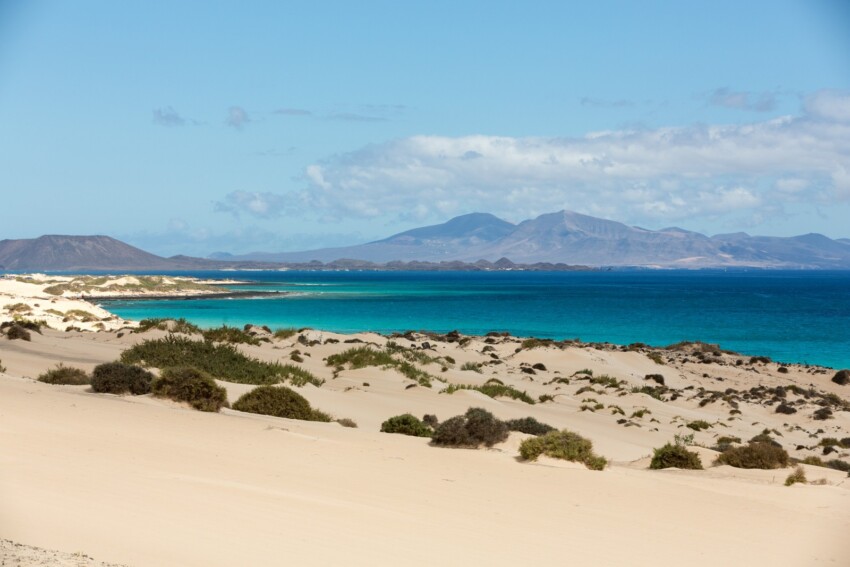
The Corralejo Dunes are part of the natural park of the same name, formed by a very long white sandy beach covering more than 2500 hectares. They are the largest dunes in the Canary Islands and are located in the north-east of the island, just south of the very touristy Corralejo.
To visit the dunes of Corralejo, simply drive along the FV-1 road, the most important on the island, which connects the capital Puerto del Rosario with Corralejo. The road passes right in the middle of the park, so that at times you will feel as if you are in the middle of the desert. Park your car on the side of the road, in a position where it is not dangerous for others, and walk into the park, walking on the beaches and dunes for kilometres and kilometres. You can get close to the sea and enjoy this immense beach in total tranquillity, or climb the 300-metre altitude of the Montana Roja volcano and enjoy the view from above.
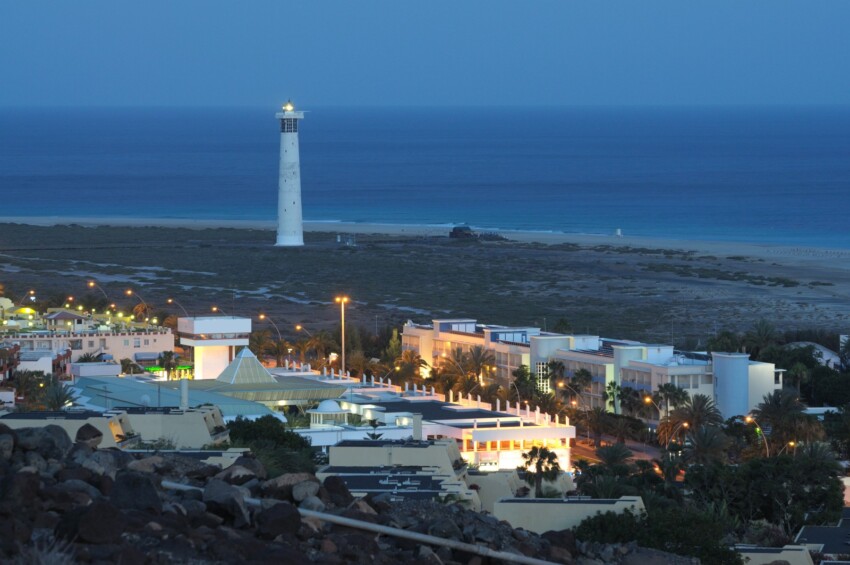
The best part of travelling in Fuerteventura is that you can find many different natural places. Among many, one of the most famous and visited is undoubtedly the Jandía Natural Park, located within the municipality of Pàjara, in the south of the island. It occupies a large part of the Jandia peninsula, the southernmost tip of Fuerteventura.
Visiting it, you will see large dunes, gentle hills and wide spaces, culminating in the Pico de la Zarza, the highest point in Fuerteventura at 807 metres. In this area there is a particular endemic flora, including the cardón de Jandía, which has become the island’s symbol. There is also an interesting fauna, especially in terms of birds, such as buzzards, buzzards and kestrels, and invertebrates, including lizards and tarantulas.
One of the main attractions of Fuerteventura is the Oasis Park, an artificial oasis in the form of a theme park that is home to more than 3,000 animals belonging to 250 different species, including giraffes, zebras and elephants, so that you will feel as if you are taking part in an African safari. In addition, the park is completed with a botanical garden where you can walk in the shade of centuries-old palm trees and cacti of all shapes and forms, and be enchanted by the endemic floral species of the Canary Islands.
You can complete your visit to the Oasis Park by taking a thrilling camel ride or an experience with lemurs. Also very interesting is the possibility of watching live demonstrations of reptiles, parrots and sea lions.
The Oasis Park is located near La Lajita, conveniently connected to the rest of the island as it is situated along the route of the FV-2 road, the main north-south thoroughfare of Fuerteventura.
A place out of this world, if only for its distance from the rest of the island’s attractions. These are the caves of Ajuy, located in a place of the same name on the southwest coast of Fuerteventura, a small fishing village of a few dozen souls more than an hour’s drive from Corralejo. These caves are so old that they are said to be the oldest rock formations in all of Fuerteventura.
You get there by parking your car at the car park in Ajuy and walking along the path carved into the rock, which takes about 20 minutes. Access to the caves is completely free and the walk is very scenic, suitable for everyone: just remember to wear comfortable shoes.
After visiting the caves of Ajuy, don’t miss the opportunity to lie in the sun on the black beach of Ajuy, surrounded by a truly beautiful setting even though it is only a stone’s throw from the houses.
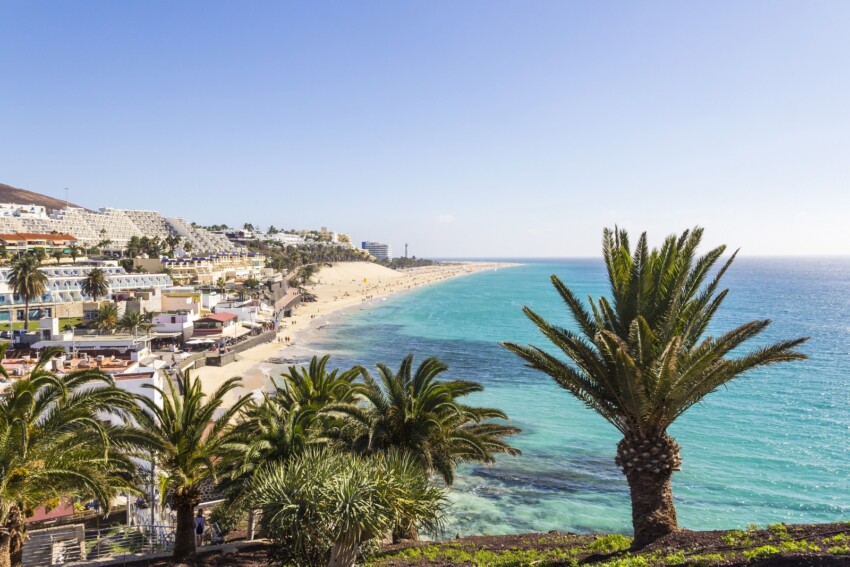
Morro Jable is a tourist resort in the south of Fuerteventura, where the very long beach that runs along practically the whole of the Jandia peninsula ends and takes on different names depending on where it touches. In this stretch, the beach is unsurprisingly called Playa de Morro Jable, and is by far the most interesting attraction in this area of Fuerteventura. Tourism in Morro Jable is mostly British and German, and holidaymakers tend to stay inside the huge all-inclusive hotels that overlook the beach.
A tip for the daredevils: a visit to Playa de Morro Jable is out of the question, but also give Playa Las Coloradas, located on the other side, a chance. Brude and unexplored, it is a refuge for lonely souls. Moreover, the rock formations behind it provide incredible colours.
Fuerteventura is an island full of volcanoes, although they are less famous than those of its neighbour Lanzarote. There are as many as 24 of them and some of them are truly amazing, such as Bayuyo, located in the north of the island, near the village of Lajares. This large volcano has two craters, the largest of which is 300 metres in diameter and about 50 metres deep. Its last eruption was 10,000 years ago but was very important for Fuerteventura, as the lava flow increased the island’s surface area by about 100 square kilometres.
The Bayuyo volcano, which is of great geological, scenic and cultural interest, can be visited by following a marked path that starts in Lajares and is about 4 kilometres long. The trail is of medium difficulty and takes about an hour and a half.
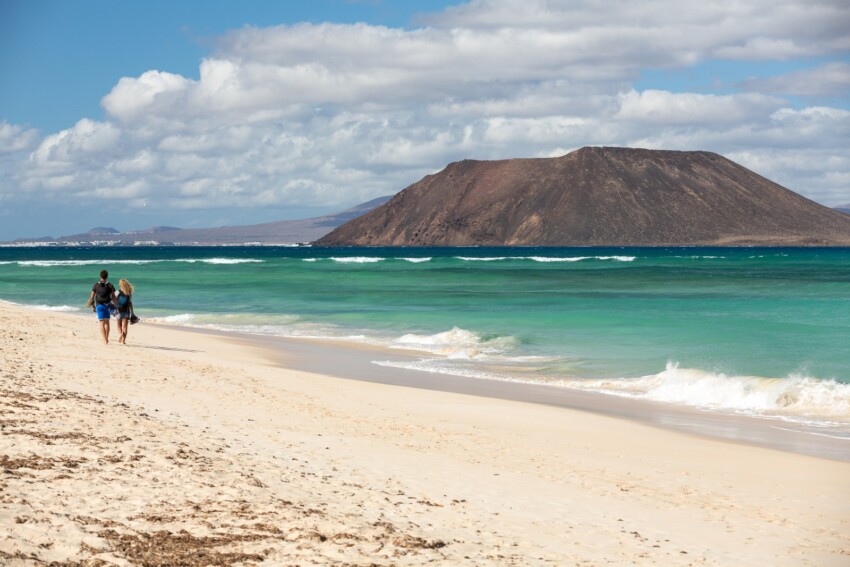
The island of Lobos is located on the islet of the same name along the northern coast of Fuerteventura. It is a virgin island and the only way to get there is by boat. To protect nature, it is not allowed to spend the night on the island, so it can only be visited on organised day trips from Corralejo.
Once there, you can follow the Lobos path, along which you will admire small volcanic cones, salt pans and the Martino lighthouse, passing by the Puertito, the small harbour for both tourists and fishermen on the island. In Lobos, in addition to enjoying the beautiful sea, you can also admire old ovens and poultry houses, dating back to the late 19th century when man first settled on the island, and some reproductions of sea lions whose colonies, now extinct, gave the island its name (literally “lobo” in Spanish means “wolf”, but “sea lobe” takes the declension of “sea lion”).
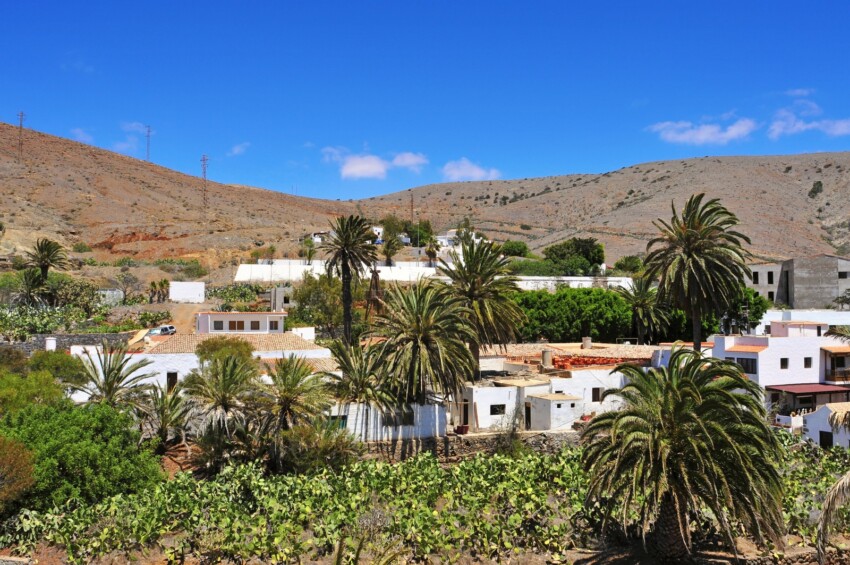
The village of Betancuria is located in the Parque Rural de Betancuria and was the capital of the island until 1834. It is a small town with typical white Spanish houses with red roofs, a real gem that took its name from Jean de Bethencourt, a Norman knight who founded it in 1404, in a position away from the sea to escape pirate attacks.
This colonial town is located in the central-western part of Fuerteventura and today depends almost exclusively on tourism. To discover its past, visit the Artizanato Museum and the Fuerteventura Archaeological and Ethnographic Museum, but also enjoy a stroll through the centre, where you will find the Iglesia de Santa María Betancuria and the Iglesia de la Concepcion, as well as the former Franciscan convent of San Buenaventura.
The Iglesia de Santa María Betancuria is the symbol of the town. It dates back to 1620 and features a magnificent stone floor, a wooden ceiling and an elaborate Baroque altar. Don’t miss the sacristy with its display of clothes. Pirates destroyed the old Gothic church in 1593, on whose foundations the building that can be visited today was built. The entrance fee also covers the adjacent Museo de Arte Sacro.
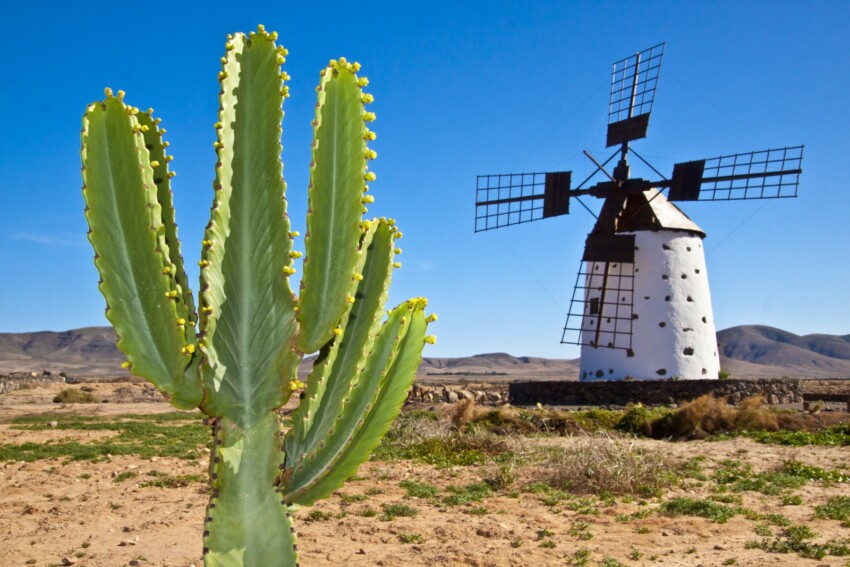
The ‘other’ of Fuerteventura’s must-see villages is Antigua, located in the east of the island. Expanses of fields, farmhouses and windmills, this is what denotes the landscape. Most of the vegetation is concentrated in the large valleys and gorges, where you can experience a feeling of peace and tranquillity.
Antigua has a rich cultural, historical and artistic heritage, brought to life mainly by its windmills, with the blades still moving today thanks to the constantly blowing winds. There are several things to see in Antigua, most notably the Mill Museum, where you will learn how wheat was milled. Also very beautiful is the Casona del Portòn, a well-preserved example of a bourgeois estate.
Fuerteventura has managed over the centuries to enrich itself with cultural and historical sites of some importance, such as the Casa de los Coroneles, the residence of the officials who presided over the island since its discovery.
This 18th century building, located south of La Oliva, has been beautifully restored, retaining some original elements. The ground floor houses temporary exhibitions of modern art, while on the upper floor you will find exhibitions on the history of the building. Don’t miss the simple chapel with its original tiled floor.
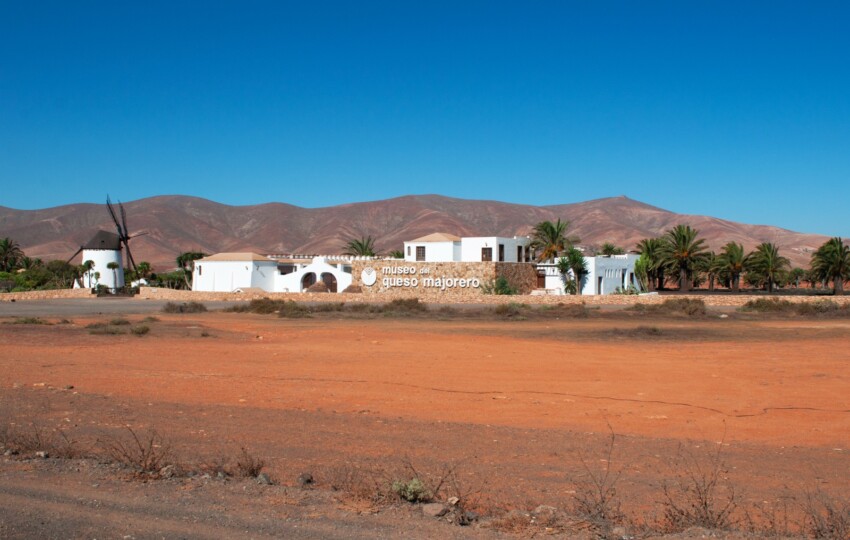
Among the museums of Fuerteventura, one of the most original is undoubtedly the recently opened Museo del Queso Majorero, dedicated to the gastronomic and cultural aspects of the place. There are some exhibits dedicated to children, concerning the world of animals, while for adults, as the name of the museum suggests, there is a careful exhibition on the production of Majorero cheese, the first Spanish goat cheese to obtain the Denominaciòn de Origen (the equivalent of the PDO mark) in 1996, as well as advice on tasting the finished product.
The museum is located in Antigua, within a complex that also contains other attractions, including a mill to produce wheat and thus create gofio, another of Fuerteventura’s culinary specialities, as well as a garden of cacti, palm trees and indigenous plants.
The Centro de Arte – Casa Mané is an art museum and a highlight of the island. Inside you will find a sculpture garden and a series of galleries containing works by Canarian artists such as César Manrique, Ruben Dario and Alberto Agullo. In addition, two galleries are dedicated to watercolourist Alberto Manrique (who has no relation to Cesar).
Casa Manè is located in La Oliva. To get there, simply drive to Casa de los Coroneles and follow the signs.
Last, but certainly not least, of the things to see in Fuerteventura is the Ecomuseo De La Alcogida, a renovated agricultural hamlet with furnished houses, outbuildings and domestic animals. The complex is an interesting glimpse of rural life in the island’s not-too-distant past, with local artisans working in some of the village buildings making lace and wicker baskets. There are explanations in English, a gift shop and a café.
This interesting museum is located near the village of Tefir, in the north-central part of Fuerteventura, and allows visitors to learn not only about the life of the typical island farmer until the advent of tourism, but also about domestic animals such as goats, donkeys or camels, as well as many flowers and trees that have adapted to the arid desert climate. Speaking of deserts, at the Ecomuseum you will also discover how water was collected in Fuerteventura in past centuries.
Fuerteventura is synonymous with desert and kilometre-long beaches, but don’t forget that we are talking about an island in the middle of the Atlantic Ocean! That’s why one of the most popular things to do for tourists is the dolphin watching tour, a boat trip to discover these cute aquatic mammals.
It is not certain that you will see them, but the probability remains quite real. The tours, led by experienced captains who know the waters of Fuerteventura like the back of their hand, will take you off the coast of the island, where you are most likely to spot them.
In the following map you can see the location of the main places of interest mentioned in this article.
